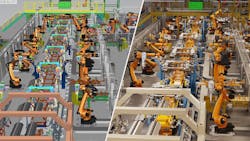Earlier this year, Siemens announced it is in the process of becoming a “tech company” with software at the center and a focus on the integration of IT and OT (operations technology). Key aspects of this transition include a greater focus on small- to-mid-sized businesses supported by expanded delivery of Siemens technology via software as a service (SaaS) along with targeted investments in cloud and edge computing, additive manufacturing, artificial intelligence, and 5G.
This week, Siemens made two additional announcements in line with this new direction: the launch of Siemens Xcelerator as an open digital business platform and a partnership with Nvidia using digital twin technology and artificial intelligence (AI) to create an industrial metaverse.
“Xcelerator is expanding, said Brenda Discher, senior vice president of business strategy and marketing at Siemens Digital Industries Software. “What started as a portfolio of engineering software, services, and application development platform is transforming into a unique digital business platform for the entire company.”
Xcelerator scope broadens
Peter Koerte, chief technology and strategy officer at Siemens, explained that Xcelerator is becoming “a curated portfolio of Internet of Things (IoT)-enabled hardware, software, and digital services from Siemens and certified third parties. Beginning with 50 partners, Koerte said Xcelerator will comprise a growing ecosystem of partners along with an evolving marketplace to facilitate interactions and transactions between customers, partners, and developers.
Initial partners involved with Xcelerator include: Accenture, Amazon Web Services, Atos, Bentley, Deloitte, Microsoft, Nvidia (see additional information below), and SAP. Access info on all Xcelerator partners.
“Customers have been telling us they are struggling to accelerate their digital transformation because data is still not flowing seamlessly between applications, therefore it's not fulfilling their business needs,” Koerte said explaining some of the industry drivers behind Siemens’ expansion of Xcelerator.
In line with Siemens earlier announcement about a heightened focus on SaaS, Koerte said the launch of Siemens Xcelerator will transform Siemens entire portfolio of hardware and software to become entirely modular, cloud-connected, and built on standard application programming interfaces (APIs). He added that Siemens and third-party offerings that are part of Xcelerator will adhere to the design principles of interoperability, flexibility, openness, and availability as-a-service.
Expanding on the open nature of Xcelerator, Koerte said, “We believe cutting edge technology will help us solve problems ranging from pandemic and supply chain issues to inflation and sustainability, but no single company can do it alone. We want to provide solutions, not a single product, that’s why we’re focused on bringing different elements together through the Xcelerator ecosystem of partners. It also means that IoT-enabled hardware, like SaaS, will be seamlessly updatable and linkable to any kind of edge or cloud device. In the consumer space— from our iPhones to our connected cars—it's very important for the technology stack to flow seamlessly. That’s why we firmly believe that if we cover the entire stack—from hardware to software—we can bring the real and digital worlds together to make the digital transformation much easier for our customers.”
While the Xcelerator portfolio will include Siemens technology ranging from building automation to government and utilities-focused technologies, Siemens noted plans to include its industrial Internet of Things (IIoT) technologies in the portfolio as Industrial Operations X. This approach is designed to bring together Siemens industrial technologies from sensors to the cloud, the company’s IoT as-a-service and low-code development capabilities, and its ready-to-use-apps, such as Performance Insight and Energy Manager.
Nvidia metaverse partnership
The first major new partnership project announced as part the expanded Siemens Xcelerator platform is with Nvidia, a supplier of graphics processing unit, networking, cloud and data center, and gaming and entertainment technologies. This partnership will focus on building an industrial metaverse using AI-driven digital twin technology
Jensen Huang, founder and CEO of Nvidia, explained that what Siemens and Nvidia are creating in this industrial metaverse is “not an animation, but a simulation that closes the gap between the real world and the virtual world.”
In Siemens’ and Nvidia’s vision of the industrial metaverse, companies of all sizes will be able to “employ digital twins with real-time performance data; create innovative industrial IoT solutions; leverage actionable insights from analytics at the edge or in the cloud; and tackle engineering challenges by making visually rich, immersive simulations more accessible.”
Roland Busch, president and CEO of Siemens AG, said, “Photorealistic, physics-based digital twins embedded in the industrial metaverse offer enormous potential to transform our economies and industries by providing a virtual world where people can interact and collaborate to solve real-world problems. When Siemens Xcelerator is connected to Omniverse, we will enable a real-time, immersive metaverse that connects hardware and software—from the edge to the cloud—with rich data from Siemens’ software and solutions. Siemens and Nvidia share a common vision that the industrial metaverse will drive digital transformation. This is just the first step in our joint effort to make this vision real for our customers and all parts of the global manufacturing industry.”
The video below from Siemens and Nvidia highlights the capabilities of the Xcelerator and Omniverse technologies that will be used to create an industrial metaverse.
Leaders relevant to this article:



